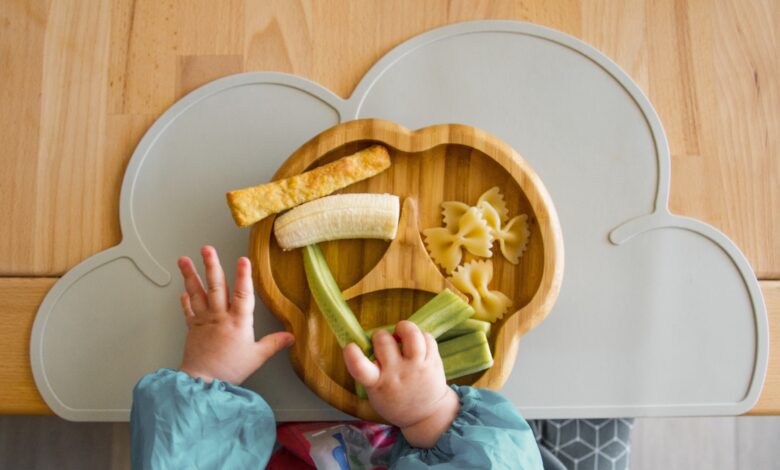Combining Baby-Led Weaning with Breastfeeding – Lovemère

As your child grows, you may find yourself wondering about introducing solid foods alongside breastfeeding. Fear not, because we’re here to guide you through the wonderful world of combining baby-led breastfeeding and breastfeeding.
Understanding baby-led weaning
Weaning foods are usually introduced around 6 months of a baby’s age. However, many mothers choose to continue breastfeeding even beyond 6 months.
Baby-led weaning is a strategy that allows your baby to explore and feed themselves solid foods. As babies grow, they eventually reduce their reliance on breast milk and begin to get most of their nutrition from solid foods.
The idea behind baby-led weaning is to understand your baby’s cues to reduce dependency on breastfeeding gradually and in a holistic way. It’s all about supporting your baby through the transition. It also encourages independence and self-regulation.
Baby-led weaning lets your baby decide when he’s ready to eat more solids and reduce breastfeeding sessions. This is a great way to help your baby try different foods.
However, remember, every baby is different. So, be patient and follow their cues.
How to gradually introduce solids?
Start by offering your baby small, soft, and easy-to-handle foods, such as cooked vegetables, fruits, and finger-sized pieces of meat. Start with one meal a day and gradually increase as your baby shows interest and readiness. Read more about introducing solids here.
Continue breastfeeding on demand
Introducing solids doesn’t mean your baby has to stop breastfeeding. Instead, look at weaning as an extension of breastfeeding where you gradually start introducing solid foods, too.
Breastfeeding remains an important part of your baby’s nutrition and bonding experience. Continue breastfeeding on demand, offering breast milk before or after solid foods as needed. Trust your baby’s cues for hunger and fullness.
It is best to breastfeed the baby at their regular feeding time before introducing solids. Try to breastfeed for about half an hour before letting them have solids. This ensures that the baby is not too hungry. If the baby is very hungry, they will not be willing to try new foods and may become more irritable.
Breastfeeding offers nutrition and also allows your baby to feel safer. Because nursing is also about providing comfort, continued breastfeeding will help your baby better adapt to new eating habits.


With the baby-led weaning approach, it is recommended that you continue to offer breastfeeding as usual. Once the baby starts eating more solids, they will gradually drop feeds. Eventually, you will see a change in the breastfeeding and feeding schedule.
Tips to manage baby weaning
As your baby starts eating solids, too, it’s natural to feel concerned about whether they’re eating enough, getting enough nutrition, and gaining weight. Here are some tips to help you get started:
1. Encouraging exploration and independence
Allow your baby to explore the textures, shapes, and tastes of food at their own pace. Sit together at mealtimes, offer a variety of healthy foods, and let your child experiment with self-feeding using their hands or baby-safe utensils.


2. Be careful with allergens
Introduce common allergenic foods one at a time, spaced a few days apart, to monitor for any adverse reactions. Examples include eggs, nuts, dairy, wheat, and fish. Discuss any concerns with your pediatrician.
3. Follow a Balanced Strategy
As you introduce solid foods, aim for a balanced diet that includes a variety of fruits, vegetables, grains, protein, and healthy fats. Offer different food groups throughout the week to ensure your baby is getting a variety of nutrients.


4. Trust Your Instincts
Remember, you know your baby best. Trust your instincts and follow their cues. On some days, your baby may eat more solids, while on other days, they prefer breast milk. It’s all part of their individual journey.
5. Continue regular check-ups of your baby
As the pediatrician examines your baby at regular check-ups, you’ll see how they’re gaining weight. A baby’s diaper output and overall energy level can also indicate that they are eating enough.
Breastfeeding your baby past their first year
Breastfeeding often remains an important part of your baby’s life for the first year even after solids are introduced. It’s only at about one year of age that your baby usually starts eating more solids. However, again, this depends on the baby and may vary slightly.


Many mothers feel pressured to stop breastfeeding at one year to encourage the baby to eat more solids. However, it is completely okay if your baby is not ready to breastfeed. The WHO recommends breastfeeding until age two or more, depends on you and your baby. So, rest assured that you are doing just fine if you are breastfeeding past the baby’s first year.
Management of constipation during weaning
As your baby transitions to solids, it’s quite common for babies to become constipated. After all, their digestive system is still developing, and it may take them time to adjust to new foods. One way to manage constipation is to keep offering water at regular intervals.


The other way to manage is to continue breastfeeding. Breastfeeding ensures that your baby gets enough fluids and stays hydrated. Offer breast milk more often if the baby is constipated and not drinking enough water.
Final thoughts
The baby-led weaning approach lets the baby take the lead when they want to reduce their reliance on breast milk. This gives them a way to meet their nutritional needs while they practice eating solid foods.
It also helps reduce your anxiety as a mother if your baby is eating enough. And of course, this is an opportunity to continue your special bond with your baby and let them find comfort as needed.
As you begin weaning baby, embrace the mess, celebrate their milestones, and enjoy the bonding moments shared at mealtimes. Be patient, trust your baby’s cues, and know that you are providing the best nourishment and love. Happy weaning and breastfeeding. 😉
Are you enjoying this post?





